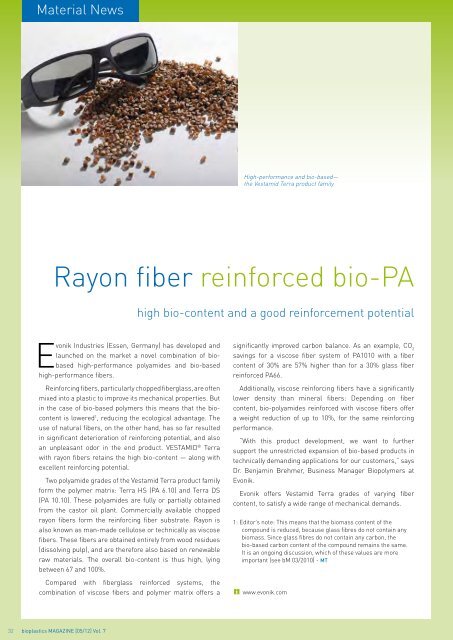bioplasticsMAGAZINE_1205
bioplasticsMAGAZINE_1205
bioplasticsMAGAZINE_1205
Create successful ePaper yourself
Turn your PDF publications into a flip-book with our unique Google optimized e-Paper software.
Material News<br />
High-performance and bio-based—<br />
the Vestamid Terra product family<br />
Rayon fiber reinforced bio-PA<br />
high bio-content and a good reinforcement potential<br />
Evonik Industries (Essen, Germany) has developed and<br />
launched on the market a novel combination of biobased<br />
high-performance polyamides and bio-based<br />
high-performance fibers.<br />
Reinforcing fibers, particularly chopped fiberglass, are often<br />
mixed into a plastic to improve its mechanical properties. But<br />
in the case of bio-based polymers this means that the biocontent<br />
is lowered 1 , reducing the ecological advantage. The<br />
use of natural fibers, on the other hand, has so far resulted<br />
in significant deterioration of reinforcing potential, and also<br />
an unpleasant odor in the end product. VESTAMID ® Terra<br />
with rayon fibers retains the high bio-content — along with<br />
excellent reinforcing potential.<br />
Two polyamide grades of the Vestamid Terra product family<br />
form the polymer matrix: Terra HS (PA 6.10) and Terra DS<br />
(PA 10.10). These polyamides are fully or partially obtained<br />
from the castor oil plant. Commercially available chopped<br />
rayon fibers form the reinforcing fiber substrate. Rayon is<br />
also known as man-made cellulose or technically as viscose<br />
fibers. These fibers are obtained entirely from wood residues<br />
(dissolving pulp), and are therefore also based on renewable<br />
raw materials. The overall bio-content is thus high, lying<br />
between 67 and 100%.<br />
Compared with fiberglass reinforced systems, the<br />
combination of viscose fibers and polymer matrix offers a<br />
significantly improved carbon balance. As an example, CO 2<br />
savings for a viscose fiber system of PA1010 with a fiber<br />
content of 30% are 57% higher than for a 30% glass fiber<br />
reinforced PA66.<br />
Additionally, viscose reinforcing fibers have a significantly<br />
lower density than mineral fibers: Depending on fiber<br />
content, bio-polyamides reinforced with viscose fibers offer<br />
a weight reduction of up to 10%, for the same reinforcing<br />
performance.<br />
“With this product development, we want to further<br />
support the unrestricted expansion of bio-based products in<br />
technically demanding applications for our customers,“ says<br />
Dr. Benjamin Brehmer, Business Manager Biopolymers at<br />
Evonik.<br />
Evonik offers Vestamid Terra grades of varying fiber<br />
content, to satisfy a wide range of mechanical demands.<br />
1: Editor’s note: This means that the biomass content of the<br />
compound is reduced, because glass fibres do not contain any<br />
biomass. Since glass fibres do not contain any carbon, the<br />
bio-based carbon content of the compound remains the same.<br />
It is an ongoing discussion, which of these values are more<br />
important (see bM 03/2010) - MT<br />
www.evonik.com<br />
32 bioplastics MAGAZINE [05/12] Vol. 7


















